LOW-MODERATE DRINKING WATER ARSENIC CONTAMINATION, CIGARETTE SMOKE, AND ADVERSE PREGNANCY OUTCOMES IN TIMIS COUNTY, ROMANIA-AMONRA
- Detalii
- Accesări: 2332
Project title: LOW-MODERATE DRINKING WATER ARSENIC CONTAMINATION, CIGARETTE SMOKE, AND ADVERSE PREGNANCY OUTCOMES IN TIMIS COUNTY, ROMANIA
ACRONIM: AMOnRA (Arsenic Molecular Outcomes Risk Assessment)
Period: 03.2021-02.2024
Budget: 1200000
Project team members
- Prof. Dr. Gurzău Eugen – Director proiect
- Dr. Neamțiu Iulia
- Prof. Bloom Michael
- Dr. Gati Gabriel
- Ing. Ch. Pop Cristian
- Prof. Dr. Berindan Neagoe Ioana
- Dr. Braicu Cornelia, CSII
- 2 poziții vacante
Summary
Adverse pregnancy outcomes, including spontaneous loss, lower birth weight, and smaller birth size have been reported in association with use of groundwater contaminated by inorganic arsenic (iAs) above 10 µg/L, the current World Health Organization maximum contamination limit. The goal of our proposed project is to determine if such adverse pregnancy outcomes are increased in association with exposure to a mixture of cigarette smoke and low-moderate level iAs contamination in drinking water. The proposed project will fundamentally advance our knowledge of how low-moderate dose iAs exposure may increase risks for adverse pregnancy outcomes among women exposed to cigarette smoke and will identify potentially modifiable risk factors on which we can act to reduce associated health risks. This is an important public health concern, given the widespread distribution of drinking water iAs contamination and cigarette smoking in some populations. Our proposed project would be the only study to examine whether use of low-moderate iAs contaminated drinking water sources may increase risks for adverse pregnancy outcomes solely and in conjunction with cigarette smoke exposure. It is also the first to examine the relevance of genetic and nutritional factors as modifiers of these associations.
Project aim:
Our main goal is to understand the risks of low-moderate drinking water iAs exposure on pregnancy outcomes, and to identify factors that predispose women to iAs-associated reproductive toxicity in regions of low-moderate groundwater contamination.
Objectives:
- Use biomarkers of exposure to cigarette smoke and iAs to confirm and better define interaction effects on adverse pregnancy outcomes we detected in our previous pilot study.
- Perform an exploratory assessment of biomarkers of genetic susceptibility to identify key

Expected results:
Expected results we anticipate, include: 1) biomarker confirmation of the interaction between cigarette smoke exposure and low-moderate drinking water inorganic arsenic (iAs) on adverse pregnancy outcomes; and 2) preliminary identification of genetic factors that predispose women to reproductive toxicity in association with low-moderate drinking water iAs exposure. When completed, our expectation is our study will provide data to develop interventions for reducing adverse pregnancy outcomes in populations with low-moderate drinking water iAs and cigarette smoke exposures.
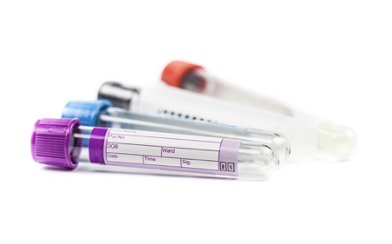
Work packages and timeline
| Year | Work packages and tasks | Estimated results |
| 2021 | Work package 1 – Development of conceptual model and operational procedures, analyses of the biological specimens and design of the databases (part I) | |
| Task 11 – Chemical analysis method development and elaboration of standard operation procedures for arsenic (As) biomonitoring |
R 1.1 Standard operation procedures for arsenic biomonitoring R 1.2 Acquisition procedures |
|
| Task 1.2 – Genetic analysis method development and elaboration of standard operation procedures for genetic assessment |
R 1.3 Standard operation procedures for genetic assessment R 1.4 Web page design |
|
| Task 13 – Development of the risk assessment model | R 1.5 Risk assessment model | |
| Task 1.4 – Determination of total and speciated As and cotinine in urine and analysis of blood Se, validation and quality control |
R 1.6 Databases with As and Se results R 1.7 Phase report |
|
| 2022 | Work package 2 – Analyses of the biological specimens and design of the databases (part II), development of the statistical models and data analyses (part I) | |
| Task 2.1 – Genetic analysis of the biological specimens, validation and quality control | R 2.1 Databases with genetic analysis results | |
| Task 2.2 – Design of the databases and integration of the biomarkers in our previous study database |
R 2.2 Integrated databases with all results
|
|
| Task 2.3 – Human As biomonitoring and exposure model |
R 2.3 Arsenic biomonitoring and exposure model R 2.4 Protocol for the statistical and toxicological analysis of the data R 2.5 Preliminary results report |
|
| 2023 | Work package 3 – Development of the statistical models and data analyses (part II), dissemination of the results and development of future intervention strategies (part I) | |
| Task 3.1 – Data management and analysis | R 3.1 Databases and preliminary results report | |
| Task 3.2 Interindividual genetic polymorphism in pregnant women exposed to arsenic via drinking water | ||
| Task 3.3 – Complex and integrated analysis of the final results by modelling, spatial distribution and GIS technics | ||
| Task 3.4 – Results dissemination (part I) |
R 3.2 Abstracts presented at professional meetings R 3.3 Articles published in national and international peer-reviewed journals |
|
| Task 3.5 – Translating science into policy – elaboration and development of intervention strategies |
R 3.4 Intervention strategies R 3.5 Phase report |
|
| 2024 | Etapa IV - Dissemination of the results and development of future intervention strategies (part II) | |
| Task 4.1 – Results dissemination (part II) |
R 4.1 Abstracts presented at professional meetings R 4.2 Articles published in national and international peer-reviewed journals R 4.3 Final report
|
Work package 2021
Results
Study participants and biological specimen collection
Study participants selection (pregnant women who lost the pregnancy (cases) and pregnant women who carried the pregnancy and delivered their babies (controls)), and the collection of biological specimens (urine and blood) from the participants, was performed in a previously conducted pilot study funded by the National Institute of Environmental Health Sciences (NIEHS) in the USA. The biological specimens were collected and stored in a biobank, at -20 ºC, to be processed and analyzed in this project.
Processing and analysis of the biological specimens
Total arsenic (As) and As species were determined in 20 of the urine samples collected by High Performance Liquid Chromatography - Inductively Coupled Plasma Mass Spectrometry (HPLC-ICPMS).
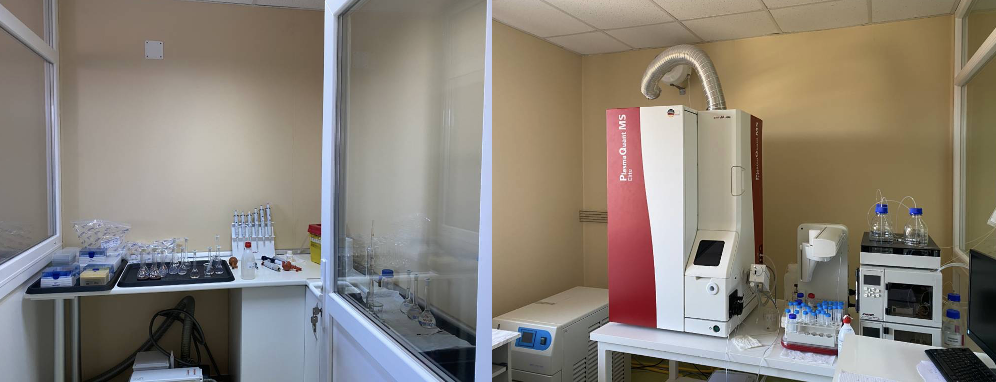
În 20 din probele de urină colectate s-a determinat arsenul (As) total și speciile de As prin tehnica cu plasmă cuplată inductiv cu spectrometrie de masă combinată cu cromatografie lichidă de înaltă performanță (High Performance Liquid Chromatography - Inductively Coupled Plasma Mass Spectrometry (HPLC-ICPMS)).
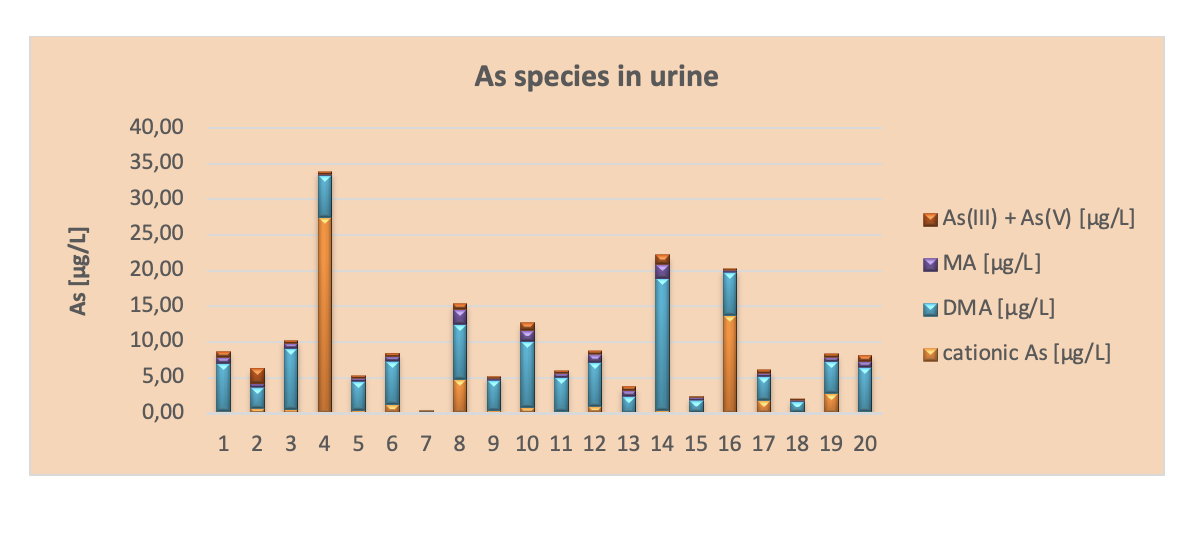
Scientific Report of work package 1 - 2021
Adverse pregnancy outcomes, including spontaneous loss, lower birth weight, and smaller birth size have been reported in association with use of groundwater contaminated by inorganic arsenic (iAs) above 10 µg/L, the current World Health Organization maximum contamination limit. The goal of our proposed project is to determine if such adverse pregnancy outcomes are increased in association with exposure to a mixture of cigarette smoke and low-moderate level iAs contamination in drinking water.
Work package 1 conducted during the year 2021, included the conceptual model of risk assessment when exposed to iAs in drinking water, standard operating procedures and partial results of the biological specimen analysis, and the design of databases. The study has a case-control epidemiological design.
The risk assessment model for metal exposure includes: a) defining the geographical scale at which the assessment will be performed; b) identification of potentially exposed population groups and subgroups with increased susceptibility; c) characterization of the pathways and routes of exposure; d) description of how the exposure will be assessed; e) determining how the hazard and dose response of the receptor will be assessed; f) description of way by which the risk will be characterized.
Human internal exposure to an environmental contaminant may be assessed by analyzing a sample from a biological fluid or tissue. This analysis aims to determine the substance itself, its metabolites, enzymes or other biological substances or responses influenced by that specific contaminant, representing what we refer to as biomarkers or indicators of internal dose. The role of biomarkers is to summarize complex information in a simplified and useful form, and to facilitate the identification of a status, trends, and correlations.
In the particular case of iAs exposure, the biomarkers that we are measuring in this project are the total urinary As and As species, using the High Performance Liquid Chromatography - Inductively Coupled Plasma Mass Spectrometry (HPLC-ICPMS) technique. We also determine the cotinine in urine, a metabolite of nicotine commonly used as a biomarker for exposure to cigarette smoke, by Liquid Cromatography - Mass Spectrometry (LC-MS) și and the blood selenium (Se) as an indicator of the nutritional status, using the ICP-MS technique. In order to provide a high degree of certainty as regards the analytical results, a series of validation parameters, imposed by national and international forums in the field, were determined (by experimental and statistical analysis) (e.g. selectivity, specificity; limit of detection, limit of quantification; work domain and linearity; sensitivity; accuracy; accuracy expressed in repeatability and reproducibility conditions; recovery; robustness; measurement uncertainty).
In 20% of the analyzed samples, the total As determined in urine exceeded the reference value of 15 µg/l.
The main area of interest in many biological and pharmacological studies is the detection of mutations for the diagnosis of genetic diseases and cancer. Many diseases have, in addition to germline mutations, somatic mutations that are not inherited and are not passed on to offspring. DPCR LNA Mutation assays with the QIAcuity dPCR platform provide accurate detection of low-frequency mutations found in a sample with a large number of healthy cells. Partitions for the wild-type (WT) and mutant (MUT) sequences in the dPCR reaction allow the MUT to be separated from the WT sequence, leading to positive partitions and amplification of the PCR signal in the dPCR, but also to the correct estimation of the concentration based on the presence or absence of the signal.
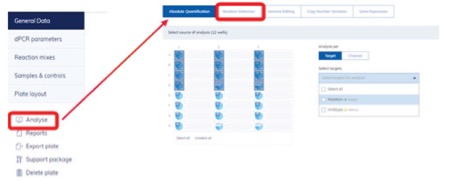
Scientific Report of work package 2 - 2022
Work package 2 comprises the analysis of biological specimens and database design (part II), and the development of statistical models and data analysis (part I).
The analyzed population sample included 300 participants (150 cases and 150 controls) with ages between 18 and 44 years, but the biochemical analyzes could only be performed in the case of participants from whom biological samples could be collected. A total of 227 urine samples were analyzed in which arsenic (As), As species and cotinine were determined, and 204 blood samples were analyzed for Se concentrations.
The databases were created in Microsoft Excel, and then, the information was imported into STATA 17 statistical package, for the statistical processing to be conducted.
In approximately 19% of the analyzed samples, the total As concentration determined in urine exceeded the reference value of 15 µg/l.
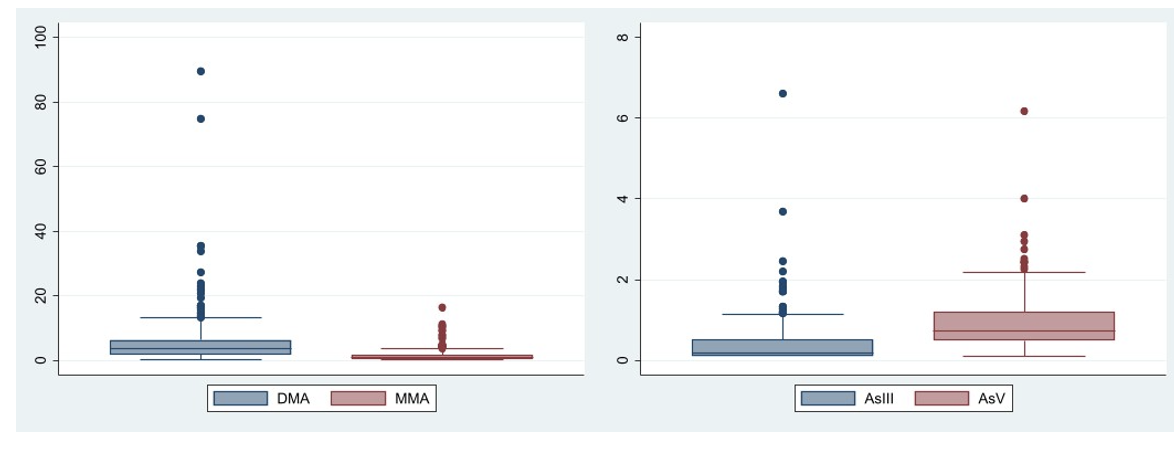
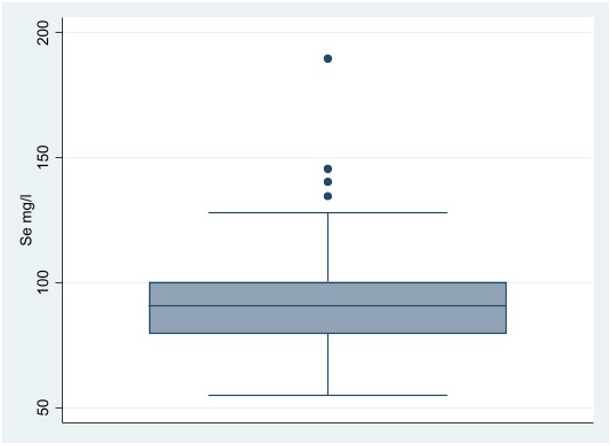
Graphical representation of median, 25th and 75th percentile, minimum and maximum concentrations of urinary As species and blood Se (µg/l)
Selenium (Se) concentrations determined in blood fell within the normal values range (except for 8 values). Values considered normal for the Se in the blood are in the interval of 50-120 µg/l, values below 40 µg/l usually indicating a Se deficiency associated with the loss of glutathione-peroxidase activity. Within the investigated sample, no values below 40 μg/l were recorded and only eight of the participants had values above 120 μg/l.
Most of the non-smoking patients had urinary cotinine values below 5 μg/l (limit of detection for the analytical method). Urinary cotinine levels were statistically significantly correlated with active smoking since pregnant, and passive smoking in the house, respectively.
Total As concentrations (µg/l) measured in urine (as a biomarker of As exposure) were positively and statistically significantly associated with the level of inorganic As concentrations (µg/l) measured in both primary and secondary drinking water sources, both being used for water consumption by the study participants.
DNA was obtained for all tested samples and dPCR analysis was performed for five "Single Nucleotide Polymorphism" (SNP), for all tested samples. Of the five SNPs analyzed, rs3740400 was the most frequently identified in the analyzed samples, followed by rs1046778 and rs3740393. The least frequently identified SNP of the five tested, is rs3740390.
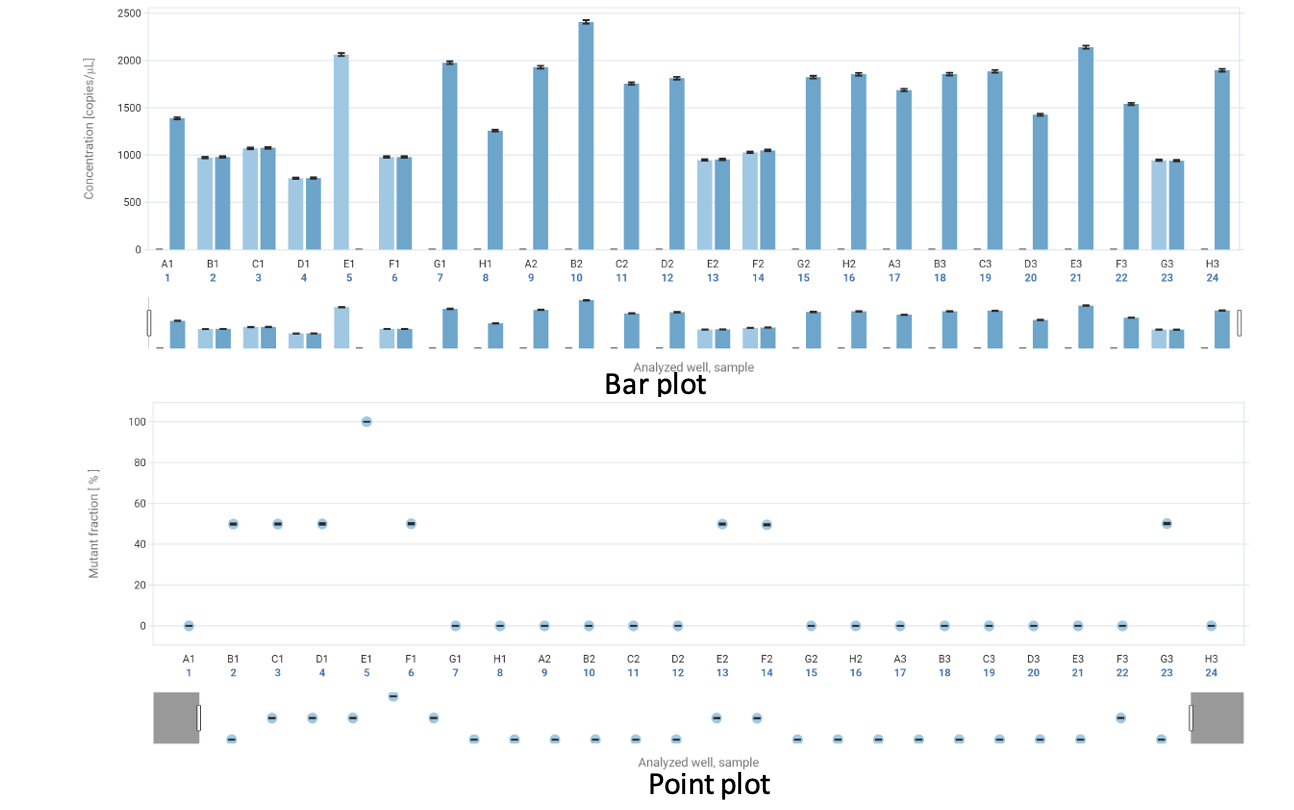
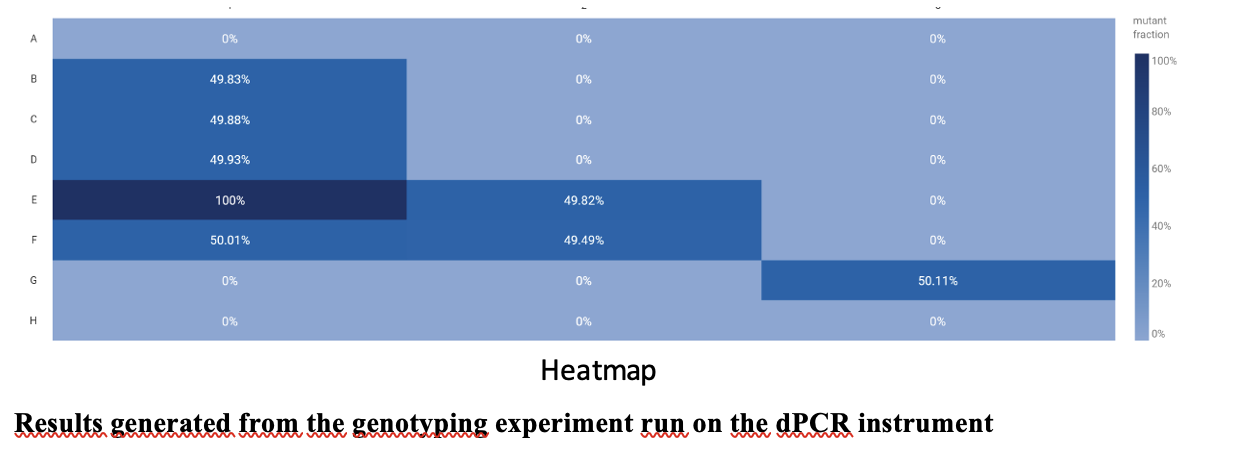
Work package 3 – 2023
Results
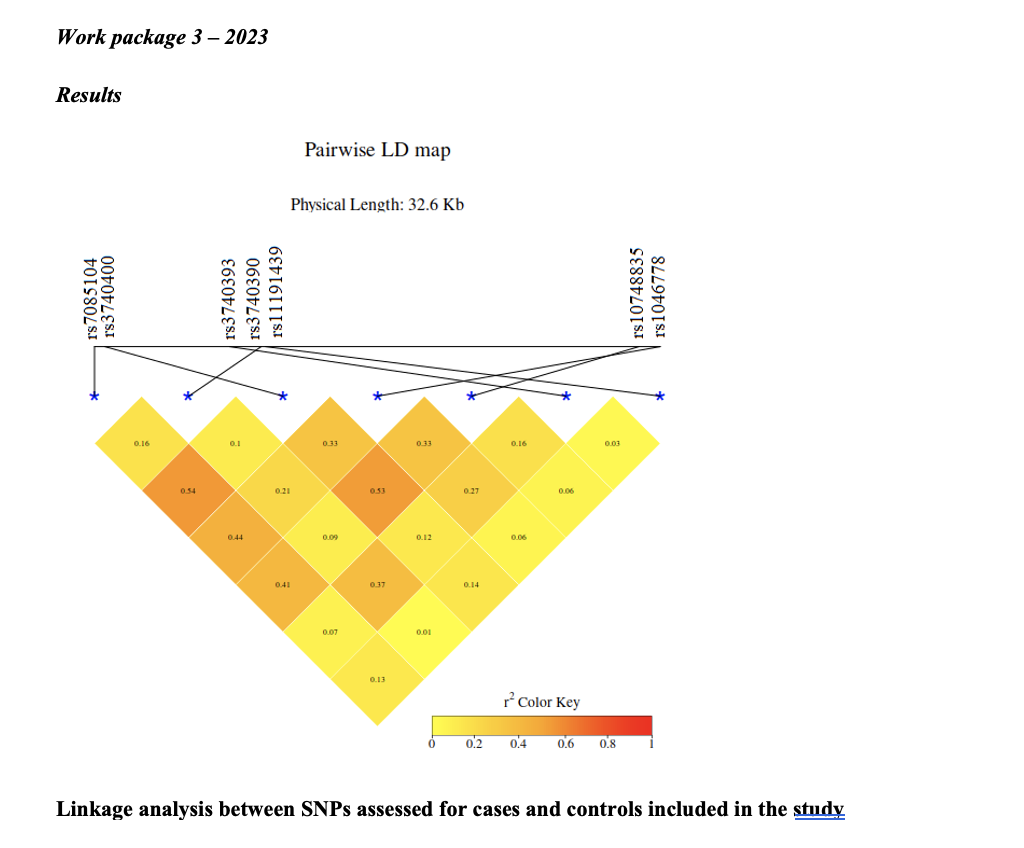

Summary of work package 3/2023
Work package III includes the development of statistical models and data analysis (part II), the dissemination of results and the development of future intervention strategies (part I).
The investigated population sample included 300 participants (150 cases and 150 controls) with ages between 18 and 44 years. A total of 227 urine samples were analysed for As, As species and cotinine, and 204 blood samples were analysed for Se.
The databases were created in Microsoft Excel, from where they were transferred into the statistical package R v.4.1.3, where the data was carried out.
Conditional logistic regression models were used to quantify associations between urinary As concentrations (without correction for creatinine) and pregnancy loss, as a function of gestational age and adjusted for confounders. For analysis and processing of variables in Geographic Information System, the interpolation method was used to observe local trends in the distribution of genetic mutations within the study population group (both cases and controls).
DNA was successfully obtained for all tested samples and the dPCR analysis for the Single Nucleotide Polymorphism (SNP) was performed in 100 samples. The analysis identified the following polymorphisms: rs10748835, rs3740400, rs7085104 and rs1046778 as the most frequent polymorphisms in the tested samples. The majority of the tested samples showed heterozygous genotypes and a small percentage of cases and controls were homozygous for the mutant allele and only in the case of some SNPs. In the samples analysed, moderate linkage was identified between the SNPs tested, except for rs11191439.
The complex statistical analysis performed showed no statistically significant association between the urinary As concentrations and pregnancy loss before 20 weeks of gestation among study participants exposed to low-moderate (mostly below 10 g/l) concentrations of inorganic As in drinking water. However, our data suggest the possibility of a higher risk associated with increased urinary As (III+V) salt concentrations and also a higher risk among women who smoke during pregnancy (urinary cotinine > 50 µg/L). Our results also showed that prenatal vitamin use may act as a protective factor, but it appears to be less protective with increasing urinary inorganic As concentrations.
For AS3MT mutations, in both case and control subjects, the various haplotypes identified do not appear localized or concentrated, their distribution indicating a weak spatial relationship. In the case subjects the identified haplotypes have higher frequencies than in the control subjects, and when intercomparing the two categories of subjects, especially in the Timisoara area, an inverse proportionality relationship can be observed.
For the APOE mutations, category 1 mutations appear more strongly distributed in Timisoara municipality and the central area of the county, towards Lugoj, in case subjects and with some discrepancy in the western and eastern areas of the county in control subjects. This distribution shows that category 1 mutations are found over a larger area in case subjects, while no mutations were identified over a larger area in control subjects.
Summary of work package 4/2024
The activities during 2024 (January and February), were only focusing on dissemination of the results. Part of the results were presented at the University of Medicine and Pharmacy days in Cluj-Napoca under a poster paper entitled: Correlation of polymorphisms As3Mt with the loss of pregnancy in women from Timisoara County, authors: Laura Ancuta Pop, author, Cecilia Bica, Iulia Neamtiu, Eugen Gurzau, Ioana Berindan-Neagoe. Meanwhile, an article was sent for publication in the International Journal of Medical Science IF 5.6: Arsenic polymorphism methyltransferase (AS3MT) and apolipoprotein E (APOE) in pregnant women exposed to inorganic arsenic in drinking water in western Romania. Both papers describe the relationship between several polymorphisms in AS3MT and APOE genes and urinary As and arsenic methabolites, as well as the relationship between these polymorphisms and pregnancy loss. “We observed that the most frequently identified AS3MT alterations in both cases and controls were in rs10748835 (80% cases and 68% controls), rs3740400 (78% cases and 64% controls), rs7085104 (74% cases and 48% controls), and rs1046778 (62% cases and 54% controls), the analysis showing more alterations in cases compared to controls. We identified 30 different haplotypes for the AS3MT-tested SNPs, with four predominant haplotypes (>8%). Cases with Haplotype 1 had four-fold higher urinary DMA concentration and two-fold higher MMA than those without this haplotype, the MMA levels were lower in cases and controls with Haplotype 4 compared to Haplotype 1, and the DMA levels were significantly lower in cases with Haplotype 4 compared to Haplotype 3. Cases with Haplotype 1 had higher levels of all analyzed biomarkers suggesting that Haplotype 1 may be associated with higher exposure to iAs and tobacco smoke.”
The results of this project
The results of this project are translated into the development and implementation of regional/national and/or local prevention programs, which meet the maternal and demographic health requirements in relation to environmental factors, namely, human exposure to arsenic in drinking water. Consequently, as the project targeted a population group of great importance in the strategy of a nation (mother and embryo/fetus), we consider the impact of the project to be a major one in terms of safety and security, resilience, and demographic problems that Romania is facing with.
The most significant results of this project consisted in providing realistic, credible, and comparable data, (methodological and organizational guarantee comparable data), leaning on validated procedures, harmonized and standardized, qualified personnel, quality assurance/quality control of the analyses carried out, and audit.
The provided results have a character of novelty and complexity for what is currently identified as specific exposure biomarkers of inorganic arsenic (urinary arsenic metabolites) and specific genetic biomarkers as indicators of individual susceptibility, and in this respect, the project brings new scientific evidence at national and international level. Consequently, this complex information and analysis addressed the development of methodologies for human biomonitoring (urinary arsenic metabolites), methodologies for the determination of individual susceptibility indicators (genetics), and last not least the development of an epidemiological design that has substantiated the assessments of the association between exposure and the investigated adverse effects. In conclusion, the project provides specific measurable indicators (biomarkers of exposure and susceptibility) to be used in the evaluation of the intervention and control strategies for arsenic exposure in drinking water, in specific areas of Romania. This project provides the health and the environment authorities, and the community in general, with measurable indicators that can be included in the primary prevention programs for population subgroups of existential importance, from the demographic perspective in Romania - the pregnant woman and the product of conception (implicitly the future of a nation).



